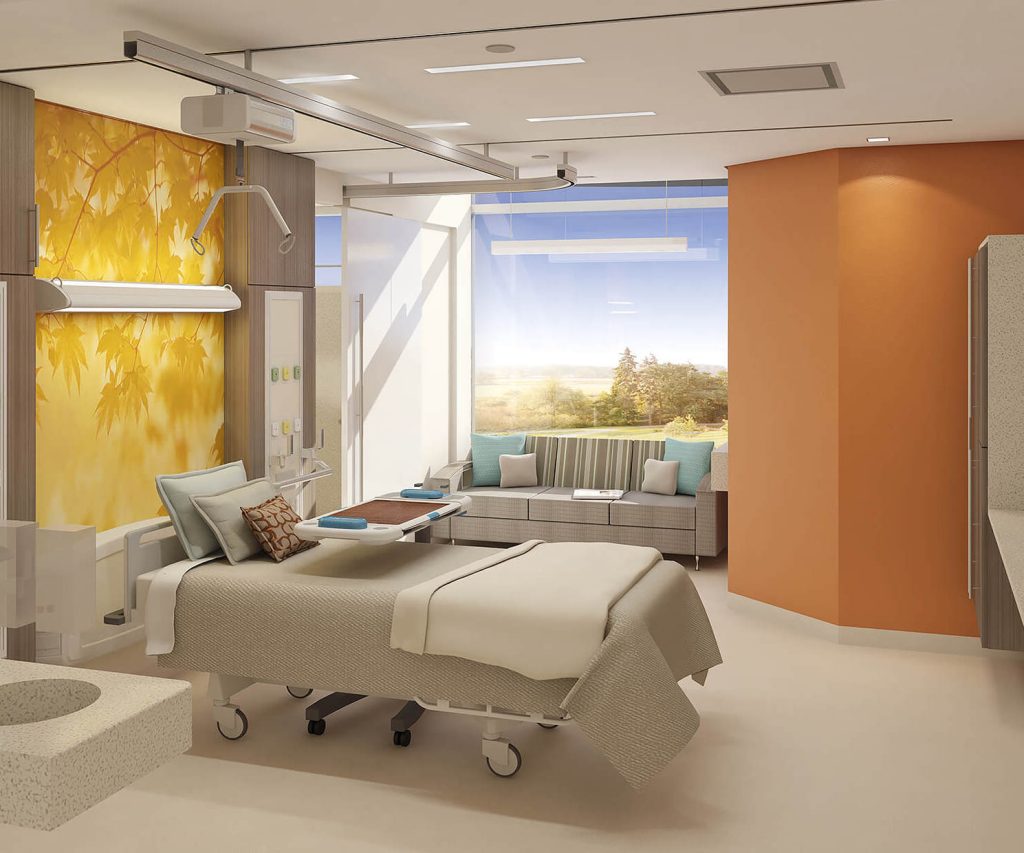
It’s been 38 years since Roger Ulrich’s study on the impact of hospital room design on patient outcomes has been published in Science magazine. In a nutshell, he found that patients with window views of nature recovered quicker from surgery and needed few pain meds vs. those who had a window view of a brick wall.
This groundbreaking study put Ulrich on the map and was the reason many healthcare architects and interior designers started designing facilities with access to nature, including hospital rooms with larger windows.
New Study Findings
I’m happy to report that researchers at the University of Michigan have replicated and expanded upon Ulrich’s study. In an analysis of 3,963 patients who underwent surgery at one hospital during a three-year period, they investigated mortality rates and lengths of stay for patients in rooms with windows or no windows, single vs. double occupancy, distance to the nursing station, and line of sight to clinicians.
Not surprisingly, their results were similar to Ulrich’s. Many more variables though.
Still, as one of the researchers, Andrew M. Ibrahim, told News-Medical, there were “clear patterns where certain room types have better outcomes after surgery.”
>>>Check out News-Medical’s more detailed summary of the key research findings.
Research on Hospital Room Design
Okay but wait a minute.
In the article, the News-Medical reporter makes a statement about how there’s very little research on how room features may impact clinical outcomes. I don’t think this is true.
When I did a search on The Center for Health Design’s Knowledge Repository for “patient room design,” 587 resources came up; and 450 appeared for “hospital room design.” Now maybe not all these are research studies like Ulrich’s or Ibrahim’s team, but that’s still a lot of evidence.
Despite these misleading claims about the lack of research on hospital room design, the University of Michigan study is good news for healthcare design industry. Because any time a study is replicated and comparable results found, it makes a stronger case for the relationship between facility design and patient health and well-being.
What’s Next
Interested in replicating this study at your hospital or health system? Or your client’s hospital or health system? Ibrahim and his colleagues are looking for collaborators.
They are also thinking about expanding it to include other metrics, like use of pain medication and level of patient satisfaction. Shouldn’t be that hard to add those to the mix.
I look forward to seeing more findings from this important work.
P.S. Please do me a favor — if you liked this post and like this blog, please share it with others by sending them the link or posting it on your Twitter, LinkedIn, or Facebook. Also, don’t forget to subscribe, so you’ll get emails when new content is posted. Thanks!
Photo: The Center for Health Design, MedSurg Patient Room concept, rendering by BSA Lifestructures.
If you like this post, please share.

What’s my story? I’m a healthcare and senior living design knowledge expert who writes and speaks frequently about trends and issues affecting these two industries. I’m also a strategic marketing consultant and content creator, working with companies and organizations who want to improve the quality of healthcare and senior living through the design of the physical environment. You can reach me at sara@saramarberry.com.


3 Responses
Dear Sara,
Thank you for catching this unsubstantiated statement about the lack of research on patient room features in the Medical News article! Our company published two peer-reviewed studies in the Health Environments Research & Design Journal back (2014, 2015) verifying positive outcomes for patients (reduced stress and anxiety) in rooms outfitted with an illusory view to open sky versus rooms with a real window, but not a view to nature (just another building). Unlike symbolic representations of the sky, the Open Sky Compositions that we used in the study use a design framework designed to engage areas of the brain involved in depth perception and spatial cognition. Today we call this type of image design part of the nascent field of neuroaesthetics. This study earned an EDRA Certificate of Research Excellence and an International Academy of Design & Health Award for best research study. We’ve presented our research at the Academy of Neuroscience for Architecture and the European Healthcare Design Conference. However, substantive contributions of environmental design to patient outcomes still continue to surprise a lot of people in the industry and the trade media. Thank you for your sharp eye and knowledge of the evidence-based design literature.
Would love to be updated on the results of any further study
In the article, the News-Medical reporter makes a statement about how there’s very little research on how room features may impact clinical outcomes. I don’t think this is true.
As a designer for human health and Trauma-informed design we KNOW good design, from empirical research, can make a difference. That reporter did not do their job. Nice design in the photo. Keep up the good work!